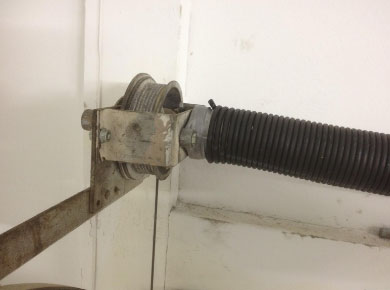Do you know what kind of part this is?
So my guess with this picture is that this is the same garage door as the previous picture; if not, this store is also very old. This torsion spring mounting setup is pretty much identical to the Easy Set torsion springs manufactured by Clopay. The only difference in the two is that this older setup does not have a mechanism built in where you can just turn a screw with a hand drill to wind up the torsion spring; this setup requires you to find the torsion spring with winding bars the conventional way.
Modern vs. Traditional Torsion Spring Mounting
The more modern way to mount torsion springs is to use a spring mounting bracket that you can screw into the header beam and bring both springs to the middle of the garage door to mount them both to the center mounting bracket. Also, if you will notice in the picture shown, there are no flag brackets existing; this door was manufactured before they started using flag brackets and center mounting brackets.
Specific Cases for Torsion Spring Installation
Now there are certain cases when installing a garage door where you might need to mount your springs on the far left and far right-hand side of the torsion pole, but you will need some different pieces of hardware to make this happen. Manufacturers make bottom brackets where you can run the cables on the outside of the door track, meaning that the cable drums will also have to be on the outside of the door track, allowing you to mount the spring directly to the bearing bracket.
Reasons for Outside Cable Setup
I have sometimes had to utilize this hardware setup called ‘cables slung outside.’ There are about two reasons that I can think of for mounting my torsion springs in this manner. One is for low headroom applications, where you do not have enough room above the torsion pole to mount a garage door opener, as the torsion springs and the bracket that they mount to usually would be in the area where you would want to mount the garage door opener rail.
Challenges in Garage Door Installation
The other reason I would use this hardware setup is if there is no wood to screw into in the part of the garage above the garage door, where you need to screw the center mounting bracket to the header. In some constructions, there will be two headers because there are living quarters above the garage, and sometimes between these two headers, there is no wood to screw into. These headers can sometimes be separated by 6 to 12 inches of dead space where there is no wood behind the drywall to screw any hardware into.
Seismic Considerations for Garage Doors
Also, on the West Coast, where you experience a lot of seismic activity and earthquakes, zoning laws are now requiring home builders to frame the garage door completely with steel I-beams. These are the same kind of I-beams that you would find in the construction of tall office buildings or skyscrapers. This will also leave dead space behind the drywall where you would need to screw in garage door track and hardware, and there is nothing behind the wall except a steel I-beam.
Advantages of Bear Bracket Installation
So mounting my torsion springs directly to the bearing brackets on the left and right-hand side would eliminate the need to mount them to a header in the middle of the garage door, especially where there is no wood to screw into. The other reason for mounting springs directly to the bearing brackets is what they call “torsion to the rear.” This setup places the entire torsion spring assembly to the rear of the garage door, directly behind the horizontal track, for extremely low headroom garage doors.
Special Considerations for Low Headroom Garages
Some garages may have water pipes or sewer pipes running along the header above the garage door, necessitating the placement of the entire torsion spring assembly. In this case, you would bring everything to the rear of the horizontal garage door track. However, you will have to use a low headroom hardware package and extra-long cables because your cables will need to be twice as long to reach from the bottom of the garage door up and around a pulley, all the way back about 8 feet to the rear of the horizontal track.
Common Issues with Rear Torsion Spring Setups
Using a rear torsion spring setup is not always recommended for some doors, and many garage door companies will not even install them. This hesitation may stem from a lack of experience with this kind of setup or concerns that it will cause problems with the garage door later on. Companies may be wary of making free service calls in the future, which is why many opt to avoid this specific hardware arrangement altogether.
